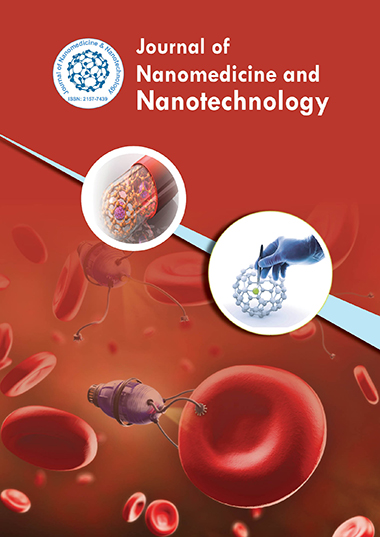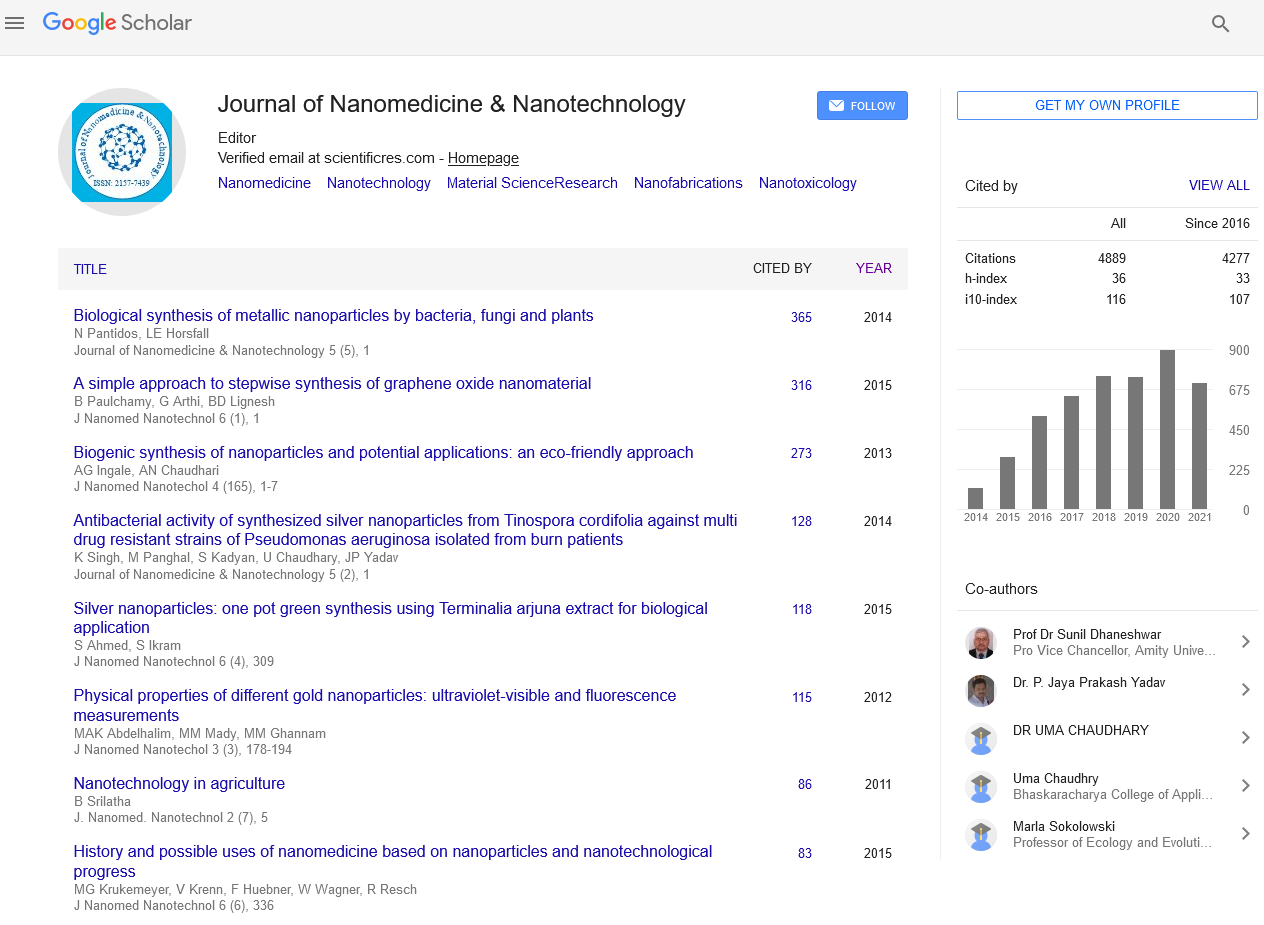Indexed In
- Open J Gate
- Genamics JournalSeek
- Academic Keys
- JournalTOCs
- ResearchBible
- China National Knowledge Infrastructure (CNKI)
- Scimago
- Ulrich's Periodicals Directory
- Electronic Journals Library
- RefSeek
- Hamdard University
- EBSCO A-Z
- OCLC- WorldCat
- SWB online catalog
- Virtual Library of Biology (vifabio)
- Publons
- MIAR
- Scientific Indexing Services (SIS)
- Euro Pub
- Google Scholar
Useful Links
Share This Page
Journal Flyer

Open Access Journals
- Agri and Aquaculture
- Biochemistry
- Bioinformatics & Systems Biology
- Business & Management
- Chemistry
- Clinical Sciences
- Engineering
- Food & Nutrition
- General Science
- Genetics & Molecular Biology
- Immunology & Microbiology
- Medical Sciences
- Neuroscience & Psychology
- Nursing & Health Care
- Pharmaceutical Sciences
Editorial - (2024) Volume 15, Issue 6
Fabrication of Multifunctional Nanoparticles for Targeted Cancer Therapy
Svea Bjorkman*Received: 02-Nov-2024, Manuscript No. jnmnt-24-28193; Editor assigned: 05-Nov-2024, Pre QC No. jnmnt-24-28193 (PQ); Reviewed: 20-Nov-2024, QC No. jnmnt-24-28193; Revised: 25-Nov-2024, Manuscript No. jnmnt-24-28193 (R); Published: 30-Nov-2024, DOI: 10.35248/2157-7439.24.15.758
Abstract
Cancer remains one of the leading causes of mortality worldwide, and despite advancements in treatment, the limitations of traditional chemotherapy, such as systemic toxicity and poor bioavailability, continue to challenge the efficacy of therapeutic interventions. In recent years, the development of multifunctional nanoparticles (MFNs) has emerged as a promising approach to overcome these challenges. These nanoparticles offer the potential for targeted drug delivery, enhanced imaging, and combination therapies within a single platform. The unique properties of nanoparticles, including their small size, large surface area, and ability to be functionalized, enable precise targeting of cancer cells while minimizing off-target effects. Multifunctional nanoparticles can be engineered to carry therapeutic agents, diagnostic agents, and imaging probes, allowing for real-time monitoring of therapy progression and treatment effectiveness. This review focuses on the fabrication methods, properties, and applications of multifunctional nanoparticles in targeted cancer therapy, with an emphasis on their potential to revolutionize cancer treatment paradigms.
Keywords
Multifunctional nanoparticles; Targeted cancer therapy; Drug delivery; Imaging; Therapeutic agents; Cancer cells; Nanoparticle functionalization
INTRODUCTION
Cancer therapy has traditionally been based on surgery, radiation, and chemotherapy, but these methods often fail to deliver optimal therapeutic outcomes due to their non-specific targeting and significant side effects. Chemotherapy, while effective in treating certain types of cancer, lacks precision and can harm healthy tissues, leading to systemic toxicity and compromised patient quality of life [1]. To address these limitations, the field of nanomedicine has introduced nanoparticles as carriers for targeted drug delivery, which aim to selectively deliver therapeutic agents to cancer cells while minimizing harm to healthy tissues. Multifunctional nanoparticles (MFNs), combining the capabilities of drug delivery, diagnostics, and imaging in a single system, are gaining significant attention as a versatile platform in the fight against cancer [2].
FABRICATION OF MULTIFUNCTIONAL NANOPARTICLES
The fabrication of multifunctional nanoparticles involves the integration of various components to provide multiple therapeutic or diagnostic functions within a single nanoparticle system. This includes the conjugation of drugs, imaging agents, and targeting ligands onto the surface of nanoparticles. The core of these nanoparticles can be made from a variety of materials, including liposomes, dendrimers, micelles, and inorganic materials such as gold, silica, and iron oxide nanoparticles. These materials are selected based on their biocompatibility, stability, and ability to be modified for specific functions [3]. Liposomes are one of the most commonly used nanocarriers due to their biocompatibility and ability to encapsulate both hydrophobic and hydrophilic drugs. Liposomes can be modified with surface ligands such as antibodies, peptides, or small molecules, which enable them to specifically target cancer cells by recognizing overexpressed receptors on the tumor surface. Additionally, liposomes can be loaded with imaging agents such as quantum dots or gadolinium-based contrast agents for real-time imaging [4]. Dendrimers, highly branched polymers with a well-defined structure, can also serve as multifunctional platforms. Their multivalency allows for the attachment of multiple therapeutic agents and targeting ligands on their surface. Dendrimers have the advantage of precise size control and the ability to encapsulate drugs in their internal cavities, while the surface functional groups can be tailored to enhance cellular uptake and targeting specificity [5]. Micelles formed from amphiphilic block copolymers are another promising platform for the delivery of hydrophobic drugs. These nanoparticles can self-assemble in aqueous environments and encapsulate poorly water-soluble drugs, thus improving their bioavailability. Targeting ligands can be attached to the micellar surface, and imaging agents can be incorporated within the micelle structure to provide diagnostic capabilities. Inorganic nanoparticles, such as gold nanoparticles (AuNPs), iron oxide nanoparticles (IONPs), and silica nanoparticles, have gained attention due to their unique optical, magnetic, and electronic properties. AuNPs are widely used in cancer therapy due to their ability to generate localized heat upon exposure to laser light (photothermal therapy) or enhance radiation therapy (radiotherapy). IONPs, on the other hand, are used for magnetic resonance imaging (MRI) and can be employed for both diagnostic and therapeutic purposes, such as in magnetic hyperthermia. Silica nanoparticles are highly versatile, capable of encapsulating drugs, serving as imaging agents, and offering surface modification opportunities for targeted therapy [6].
TARGETED DELIVERY MECHANISMS
The primary advantage of multifunctional nanoparticles in cancer therapy lies in their ability to target specific cancer cells while avoiding healthy tissues. This selectivity is primarily achieved through the functionalization of nanoparticle surfaces with targeting ligands, which can be proteins, antibodies, peptides, or aptamers. These ligands bind to overexpressed receptors on the surface of cancer cells, allowing for efficient drug delivery and minimizing off-target effects. For example, nanoparticles functionalized with antibodies that specifically target epidermal growth factor receptor (EGFR) or HER2/neu are commonly used for targeting breast, lung, and colorectal cancers. Other ligands, such as folate, have been widely used for targeting folate receptors that are overexpressed in ovarian and kidney cancers. Additionally, small peptides that bind to tumor vasculature or specific tumor markers can also be used for targeted delivery. Another important aspect of targeting is the use of stimuli-responsive nanoparticles, which release their payloads in response to specific environmental conditions such as pH, temperature, or enzyme activity. The acidic microenvironment of tumors, for instance, is often exploited for pH-sensitive drug release. Additionally, nanoparticles can be designed to release their cargo in response to external stimuli such as near-infrared light or magnetic fields, further enhancing the precision of therapy [7].
IMAGING AND DIAGNOSTICS
Multifunctional nanoparticles offer the added benefit of enabling real-time monitoring of the therapeutic process. By incorporating imaging agents such as quantum dots, superparamagnetic iron oxide nanoparticles, or fluorescent dyes into the nanoparticle matrix, clinicians can track the distribution and accumulation of nanoparticles in vivo. These imaging modalities allow for non-invasive monitoring of tumor targeting and therapy progression. Quantum dots, for example, are fluorescent semiconductor nanocrystals that emit bright, size-tunable light and are increasingly used for fluorescence imaging. Their high quantum yield and photostability make them ideal candidates for long-term tracking of nanoparticles in vivo. Magnetic resonance imaging (MRI) can also be enhanced by using iron oxide-based nanoparticles, which provide excellent contrast for detecting tumors and monitoring therapy [8].
APPLICATIONS IN COMBINATION THERAPIES
One of the most promising aspects of multifunctional nanoparticles is their ability to combine multiple therapeutic modalities into a single platform. For instance, chemotherapy can be combined with photothermal therapy (PTT), where nanoparticles are engineered to carry chemotherapeutic agents while also being capable of generating heat upon exposure to near-infrared light. This combination not only maximizes therapeutic efficacy but also reduces the likelihood of resistance development. Other combination approaches include the integration of chemotherapy and immunotherapy using nanoparticles that can carry both chemotherapeutic drugs and immune-boosting agents such as cytokines or checkpoint inhibitors. These multifunctional platforms hold the potential to enhance anti-tumor immunity while simultaneously targeting the tumor directly with chemotherapy [9].
CHALLENGES AND FUTURE DIRECTIONS
While the potential for multifunctional nanoparticles in cancer therapy is vast, several challenges remain. These include issues related to scalability, regulatory approval, and biocompatibility. The fabrication methods for nanoparticles need to be reproducible and cost-effective, especially if they are to be translated into clinical practice. Additionally, the long-term safety and toxicity profiles of nanoparticles must be thoroughly evaluated to ensure that they do not induce adverse effects in patients. Future research will likely focus on optimizing the design of multifunctional nanoparticles, enhancing their stability in biological environments, and improving the targeting efficiency of cancer cells. Moreover, the integration of new therapeutic modalities, such as gene therapy, into nanoparticle platforms offers exciting prospects for treating cancer at the molecular level [10].
CONCLUSION
The fabrication of multifunctional nanoparticles represents a promising frontier in cancer therapy, offering a highly versatile platform for targeted drug delivery, imaging, and combination therapies. By integrating multiple functions into a single nanoparticle system, these nanocarriers can potentially revolutionize the treatment landscape for cancer, enabling more effective, precise, and personalized therapies. As research continues to advance in this field, the clinical translation of multifunctional nanoparticles holds great promise for improving cancer outcomes and enhancing patient quality of life.
REFERENCES
- Sharma N, Baldi A, Garg S. Â Cyclodextrins: encapsulation of drugs. Critical Reviews in Therapeutic Drug Carrier Systems. 2019; 19(3): 185-208.
- Narayanan N, Sudhakumari C C. Cyclodextrin as a tool in enhanced drug delivery. Polym Renew Resour. 2021;10(2): 77-84.
- Smith, K A, Buhro, W E. Synthesis of surface-stabilized beta-cyclodextrin/gold nanoparticle assemblies. Nanoscale Advances. 2020; 2(2): 527-535.
- Xia Q, Cai Y, Zheng J, Zhang J. Nanomaterials-based photothermal therapy and its potentials in antibacterial treatment. Journal of Controlled Release. 2021; 330: 75-90.
- Narayanan, K B, Sakthivel N. Green synthesis of biogenic metal and metal oxide nanoparticles and their effect on the bioactivity of pharmaceuticals. Journal of Molecular Liquids. 2020; 300: 112202.
- Li Z, Zhang Y, Fullston D, Shen Y. Advanced carbon-based nanomaterials for tumor photothermal therapy. Nanomaterials. 2021;11(5): 1137.
- Wang Y, Qi X, Lu L, Xu X. Anticancer properties of sulfated chitosan. Biol Trace Elem Res. 2019;192(2): 205-212.
- Li J, Wang X, Zhang T, Wang C, Huang Z, Luo et al . Polypyrrole/chitosan-coated Fe3O4 nanoparticles for MRI-guided photothermal cancer therapy. Biomedical Materials. 2020; 15(4): 045001.
- Brown S A, Hansbro, P M, Hansbro, N G. Animal models of asthma: value, limitations and opportunities for alternative approaches. Drug Discovery Today. 2019; 24(1): 206-218.
- Jones, J R, Barrère F, van Blitterswijk, C A. Calcium phosphate ceramics as bone graft substitutes in filling bone tumors. Pharmaceuticals. 2020; 3(3): 125.
Indexed at, Google Scholar, Crossref
Indexed at, Google Scholar, Crossref
Indexed at, Google Scholar, Crossref
Indexed at, Google Scholar, Crossref
Indexed at, Google Scholar, Crossref
Indexed at, Google Scholar, Crossref
Indexed at, Google Scholar, Crossref
Citation: Svea B (2024) Fabrication of Multifunctional Nanoparticles for Targeted Cancer Therapy. J Nanomed Nanotech. 15: 758.
Copyright: ©2024 Svea B. This is an open-access article distributed under the terms of the Creative Commons Attribution License, which permits unrestricted use, distribution, and reproduction in any medium, provided the original author and source are credited.


